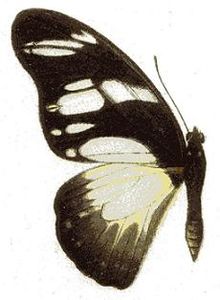| Graphium almansor | |
|---|---|

| |
| Scientific classification | |
| Domain: | Eukaryota |
| Kingdom: | Animalia |
| Phylum: | Arthropoda |
| Class: | Insecta |
| Order: | Lepidoptera |
| Family: | Papilionidae |
| Genus: | Graphium |
| Species: | G. almansor |
| Binomial name | |
| Graphium almansor (Honrath, 1884) | |
| Synonyms | |
| |
Graphium almansor, the Almansor white-lady swordtail or Honrath's white lady, is a butterfly in the family Papilionidae (swallowtails). It is found in Guinea, Ghana, Togo, Nigeria, Cameroon, the Republic of the Congo, Angola, the Central African Republic, the Democratic Republic of the Congo, Sudan, Ethiopia, Uganda, Kenya, Tanzania, Zambia and possibly Rwanda and Burundi.
Description
Markings white; median band of the forewing also broadly interrupted in cellule 2, as the discal spot of this cellule is absent or very small; the transverse spot of the cell of the forewing reaches the front margin of the cell, but is rather broadly separated from the discal spot in cellule 3; hind¬wing without discal dots and with indistinct or partly absent submarginal dots, the apex of the cell filled in with white; the cell of the forewing with a white apical spot; the discal spot in cellule 1 b of the fore¬wing does not reach so far basad as the spot in 1 a and is therefore shorter. —- Ashanti and Angola. G. carchedonius Karsch only differs from almansor in that the discal spots in 1 a and 1 b of the forewing are both obliquely rounded off proximally and the cell of the forewing has no apical spot. — Togo and Congo region. G. uganda the white markings of the fore¬ wing are much reduced, consisting only of three short streaks in the middle of the cell, small discal spots in 1 a, 1 b and 3, two streaks in cellule 6, a broken discal spot in 8 and submarginal dots in 1 b, 2, 3 and 6; the discal spot in 1 a is placed much nearer to the base than that in lb; the transverse band of the hind¬ wing is somewhat yellowish, covers the apex of the cell and is incised in cellules 2 and 6, but without discal spots.Uganda.
Biology
Adults of both sexes mimic Amauris species, including Amauris damocles and species of the Amauris echeria-group. Males are attracted to damp spots on river banks (mud-puddling) and both sexes feed from flowers.
The larvae feed on Pseudospondias microcarpa.
Subspecies
- Graphium almansor almansor (Angola, Democratic Republic of the Congo, northern Zambia)
- Graphium almansor birbiri (Ungemach, 1932) (south-western Ethiopia)
- Graphium almansor carchedonius (Karsch, 1895) (Guinea, Ghana, Togo)
- Graphium almansor escherichi (Gaede, 1915) (eastern Nigeria, Cameroon, Congo, Central African Republic, Democratic Republic of the Congo, southern Sudan, Uganda)
- Graphium almansor uganda (Lathy, 1906) (Democratic Republic of the Congo, Uganda, south-western Kenya, north-western Tanzania, Rwanda, Burundi)
Taxonomy
Graphium almansor belongs to a species group with 16 members. All are very similar The species group members are:
- Graphium abri Smith & Vane-Wright, 2001
- Graphium adamastor (Boisduval, 1836)
- Graphium agamedes (Westwood, 1842)
- Graphium almansor (Honrath, 1884)
- Graphium auriger (Butler, 1876)
- Graphium aurivilliusi (Seeldrayers, 1896)
- Graphium fulleri (Grose-Smith, 1883)
- Graphium hachei (Dewitz, 1881)
- Graphium kigoma Carcasson, 1964
- Graphium olbrechtsi Berger, 1950
- Graphium poggianus (Honrath, 1884)
- Graphium rileyi Berger, 1950
- Graphium schubotzi (Schultze, 1913)
- Graphium simoni (Aurivillius, 1899),
- Graphium ucalegon (Hewitson, 1865)[
- Graphium ucalegonides (Staudinger, 1884)
Images
References
- Honrath, E. G. 1884. Neue Rhopalocera. Berliner Entomologiche Zeitschrift 28: 203-212.
- Graphium, Site of Markku Savela
- Afrotropical Butterflies: File C – Papilionidae - Tribe Leptocercini
- Aurivillius, C. 1908-1924. In: Seitz, A. Die Großschmetterlinge der Erde Band 13: Abt. 2, Die exotischen Großschmetterlinge, Die afrikanischen Tagfalter, 1925, 613 Seiten, 80 Tafeln (The Macrolepidoptera of the World 13).Alfred Kernen Verlag, Stuttgart.
 This article incorporates text from this source, which is in the public domain.
This article incorporates text from this source, which is in the public domain.
- Ungemach, H. 1932. Contribution a l’etude des Lepidopteres d’Abyssinie. Memoires de la Societe des Sciences Naturelles (et Physiques) du Maroc 32: 1-122.
- Karsch, F. 1895 Aethiopische Rhopaloceren. I. Entomologische Nachrichten. Berlin 21: 275- 286.
- Gaede, M. 1915a. Neue afrikanische Lepidoptera des Berliner Zoologischen Museums.Internationale Entomologische Zeitschrift 9: 38-40; 71-74.
- Lathy, P.I. 1906 A contribution towards the knowledge of African Rhopalocera.Transactions of the Entomological Society of London 1906: 1-10.
- Carcasson, R.H 1960 The Swallowtail Butterflies of East Africa (Lepidoptera,Papilionidae). Journal of the East Africa Natural History Society pdf Key to East Africa members of the species group, diagnostic and other notes and figures. (Permission to host granted by The East Africa Natural History Society
- Lewis, H. L., 1974 Butterflies of the World ISBN 0-245-52097-X page 89, figure 2.
| Taxon identifiers | |
|---|---|
| Graphium almansor | |
This Papilionidae-related article is a stub. You can help Misplaced Pages by expanding it. |